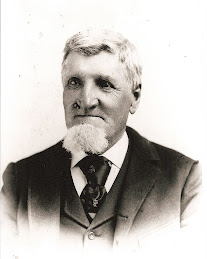When Robert Gardner arrived in Dalhousie with two of his children, William and Mary, he found that the land was not the quality the emigrants had hoped it would be at the time of their departure from Scotland. The area was covered with heavy timber. Most of the trees had grown to a diameter of two to three feet, and they grew abundantly in the areas with the best soil.(1) Hemlock, pine cedar and hardwood trees had to be cleared by hand before the land could be cultivated.(2) There were many swamps and mud lakes in the area as well, which supported a large mosquito population and the spread of disease.
Archibald wrote, “after he Landed in America they took Land in Bathurst District the goverment giveing it free but it was generly Rocky and cold . . . My Father & William & Mary started from Lanark their camping place . . . and took land 7 miles back in the woods & comenced to build A Log cabin & packed all their Luggage on their back without A Road through swamps & over Logs[.]”(3)
A description of the process of clearing the land in this part of Upper Canada was written in 1819.
“The work is begun by cutting the small trees or undergrowth, then the large ones are chopped about three feet from the ground. The method is to cut them on the side they lean to, which is always observed before they begin the work. The incision is continued until it passes two thirds of the tree; then on the opposite part, when it falls. Many of these trees are from fifty to eighty feet without a branch. When on the ground, the branches are cut off, and thrown in heaps; then the body of the tree is cut into lengths of twelve feet. . . . When done, an immense heap of trunks and branches is scattered all over the land. It lies in that state for a month or two, and when dry enough to burn, fire is put to it . . . . The fire having passed over every part of the land, it is a favourable sign for the future expectation of the farmer, as it kills all the under growth. The trunks of the trees being thick, are not all consumed, and oxen are employed to draw them to a place, where they are piled up and burnt by themselves.”(4)
After the trees were burned, the ground around the tree stumps was planted. It took fifteen to twenty years before the stumps had decayed sufficiently to remove them from the land. The settlers in this area plowed with an American hog, sometimes called a Dutch plough, because it worked well among the rocks and stumps.(5)
Robert Gardner did not have oxen or any other animals to help him in the clearing of his land. Archibald wrote, “the[y] Loged by Hand carried all their Rails on their shoulder Made Bridges carrying the Logs & all their Log houses[.]”(6) In spite of the hardships, Robert Gardner was able to clear and plant ten acres of land his first year in Dalhousie.
1. Charles F. Grece, Facts and Observations Respecting Canada, and the United States of America: Affording a Comparative View of the Inducements to Emigration Presented in Those Countries (London: J. Harding, 1819), 32.
2. Robert Gardner, Jr., Robert Gardner, Jr., 1819-1906: Utah Pioneer 1847 (Cedar City, Utah: n.p., 1973), 1.
3. Archibald Gardner, Autobiography (1858), 3.
4. Grece, Facts and Observations, 34, 35.
5. Grece, Facts and Observations, 35, 36.
6. Archibald Gardner, Autobiography, 3.
Friday, February 5, 2010
Subscribe to:
Post Comments (Atom)





My word! He did 10 acres of land without oxen. Wow! When you hear this, you realize how spoilt we are today!
ReplyDelete